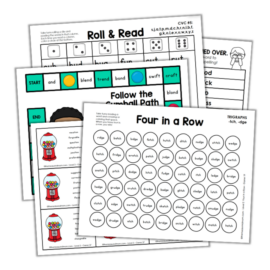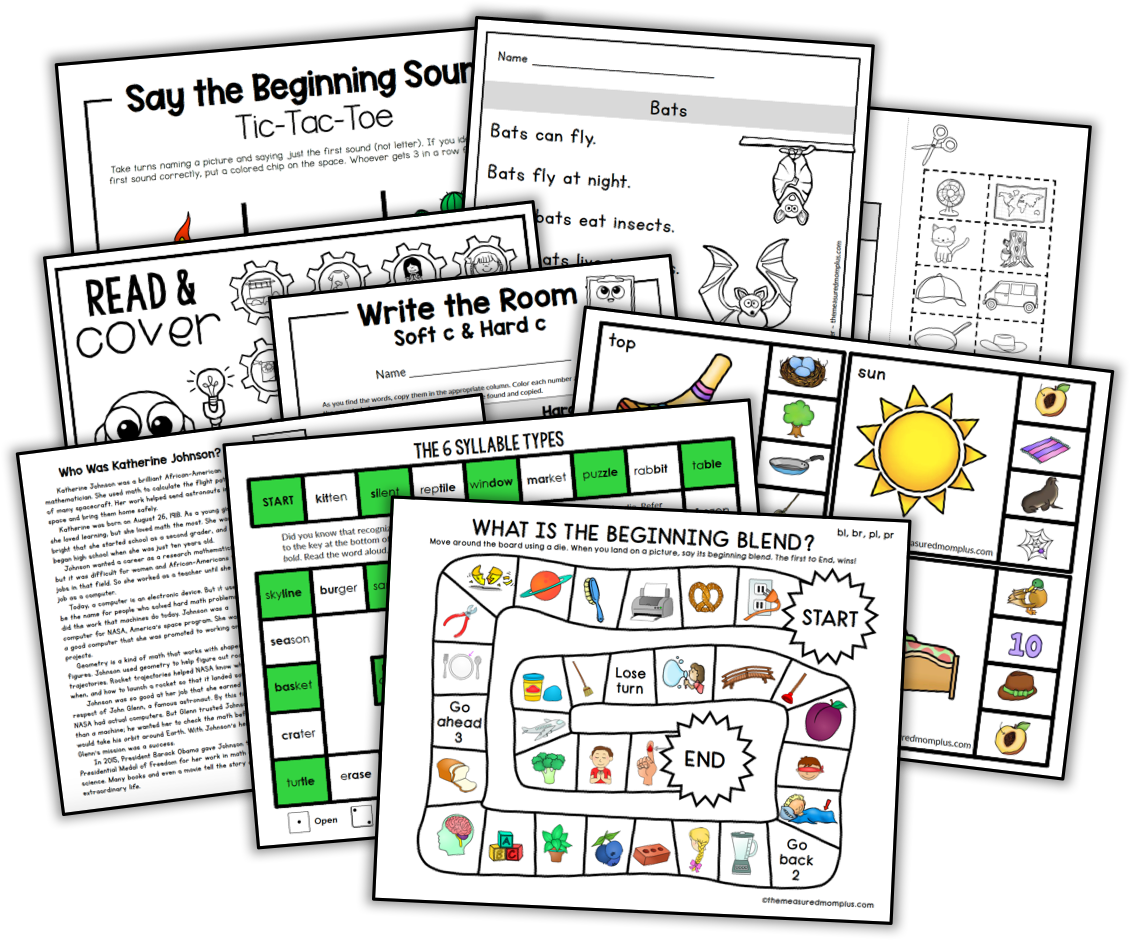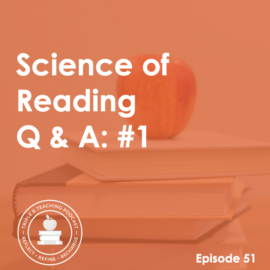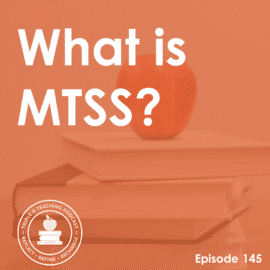
TRT Podcast#72: How to keep the rest of the class learning while you meet with small groups
Keep the rest of the class busy AND learning with these easy-prep, effective literacy center ideas!
Listen to the episode here
Full episode transcript
Hello, Anna Geiger here from The Measured Mom, welcome to episode 72! We're going to talk about what the rest of your students are doing while you're meeting with your small groups.
Last week we talked about why I think it's so powerful to meet with small groups for phonics lessons versus teaching that skill to the whole class and how you can differentiate within those lessons. I talked about how to form and schedule the meetings with those groups and what to do when you're meeting with them.
That's all really good and really valuable, BUT if you have students over here who are misbehaving, who are noisy, or who are off task, your small groups are not going to go well, so we really need to nail down what the rest of the class is doing.
I want to give you five ideas for literacy centers, these are literacy centers that I think are powerful and not just busy work. You will teach your students how to do the activities at each of these centers, and then when that's all in place, you can start your small group phonics lessons.
Number one: your students should be doing some kind of word work. I think a really good thing to do is have a center or two that is focused on having them read the words that have the pattern that you've taught. These can be word lists, words within a game and so on.
I've recently created a bunch of games that would fit for this center. We've got "Roll & Read" where students roll a die and then read that column.
Then we have "Follow the Path," where students roll a die to move along a board. When they land on a gumball, they read a card. When they land on a space, they read just one word, but the gumball card is four or five words for extra practice.
We also have "Four in a Row" where we've got all the words on a grid and students take turns reading a word and covering it, and trying to be the first to get four in a row.
We even have a Buddy Spelling Game, which helps students practice encoding the words that you've taught in their phonics lessons. It is a partner game, of course, where students read the word to their partner when they land on a certain numbered space, they practice spelling it, and then they check their spelling.
These are all great ideas for word work phonics centers. What you want to make sure is that the games you use are pretty consistent from week to week in terms of format. Because when you do that, you save yourself a ton of time from kids coming up and asking, "I don't know how to play this. What do we do again?" or arguing about how to play. When they consistently recognize the format of the game, they can get started right away and use their time really well. So that's one center, word work or phonics centers.
Another center, I think, should be independent reading where they are practicing reading texts with the phonics patterns that you've taught them. I personally have always liked when kids have a gallon size plastic bag with their name on it, but if you have room, you could have actual book bins. The nice thing about the gallon bags is they fit into a milk crate standing up. You could have them grab their bag, pull out their books, and they practice reading them independently - probably out loud if they're very young.
You could get those PVC pipe whisper phones that they can hold up to their ear. That way they can read very quietly, but actually hear it amplified in their ear. It's less disturbing to others and allows them to be able to hear the words and kind of block out the other noise at the centers.
In terms of how to fill those bags, I recommend including the books that you've finished with them in your small group phonics centers, the decodable books, as well as books that have the patterns you've taught them, but they may not have seen yet.
So let's say you're teaching CVCE words. You could still have some review books in there that have CVC words, or once they're solid with CVCE, other books that have the CVCE pattern that you've printed from offline or that you've purchased.
Then you'll have some students who are ready for leveled books, and they won't necessarily need a bag full of decodable books. That's up to you and your discretion in terms of what each particular child is ready to handle. If kids are still going to the picture to try to solve words, they're not ready for leveled books. However, if their phonics knowledge is pretty good, they're able to figure out words using their phonics knowledge as their first go-to versus going to the picture or context, then they're likely ready for other types of books. But I think it's valuable to review and practice those decodable books you've used in your lessons.
Another center that I think is a great idea is a listening center. You can set them up with books they can listen to on an iPad or another device using earpods or headphones, and you might also have some kind of response. So you might have a picture response, where for each book they listen to they draw a picture. If they're ready, maybe a simple graphic organizer, like the most important information or the beginning, middle, end, or problem and solution.
Another good center to have is a buddy reading center. Here students are working together, and they can each read a page or they can each read a paragraph depending on how long their books are. At the buddy reading center, you're going to have them practice reading decodable text, if you think that's a good idea for these particular students, or you could have copies of poems you've read for shared reading, or you could have partner plays, or readers theater.
Personally, I prefer to have buddy reading students be pretty close to the same level, so that they're actually each being challenged and not having someone who's way advanced tutoring someone who's really struggling, but if you think that's a good choice for a particular week, you could do that.
Finally, it's a good idea to have a center where students practice reading high frequency words, so that when you've taught your high frequency words in your small groups, now you have a place for that particular group to find their material.
I didn't mention this yet, but I recommend color coding your groups and color coding their materials at the center in colored file folders or some other way of color coding. So if you've got your lowest group and let's say it's the green group, then over at the centers, they know that their buddy reading material is in the green folder. They know that their phonics games are in the green folder, their high frequency word flashcards again are in a green folder or a bag with a green sticker on it. You want it to be very, very clear for them where their materials are. It also makes it easier for you.
So in terms of things they could do at the high frequency word center, they could quiz each other there with flashcards and time them to see how long it took them to read the words, and they could maybe keep track from week to week. You could have them play a game that you've created from an editable game that you've purchased somewhere, where you can just type in the words that they've learned so far, and they just practice reading them over and over in the game. You might have phrases on cards that include the high frequency word for them to practice reading. Those are all things that you can do to help your students learn their high frequency words.
Let's review quickly the five centers that we talked about today. Number one, I think, is really one of the most important, and that's your phonics or word work centers where you're going to have them practice applying the phonics skills you've taught in your small groups.
Right up there as a really important center would be independent reading, where you have them each have a gallon size plastic bag filled with books that they're able to read on their own and that they practice reading during that center.
You could also have buddy reading where students practice reading decodable text or partner plays, readers theater, poems, and other material that they can handle, and they read that with a buddy.
You could also have a listening center where students listen to books on an iPad and possibly do a written response.
Finally, we talked about high frequency words, where you have a way for them to practice the words that you're helping them turn into sight words - words they recognize automatically without needing to sound out or guess.
Just as a reminder, I've got that Mega Bundle of Phonics Games ready in my shop. I want to let you know that I'm going to give you a special link to check out the games. If you purchase within one hour of visiting this link, you can get all the games for $27. If you purchase all the files separately, it's $76. If you purchase the bundle, it's $49, but if you get this special offer, it's $27 as of the spring of 2022. Prices may change in the future.
To check out this special offer, head to themeasuredmom.com/phonicsgames. I'll also link to that in the show notes for this episode, which you can find at themeasuredmom.com/episode72. Thanks for listening and I'll talk to you again next week!
Sign up to receive email updates
Enter your name and email address below and I'll send you periodic updates about the podcast.

Get this bundle of 12 FREE phonics games!
Related resources
- Multi-level partner plays (great for buddy reading!)
- Editable reading games (great for high frequency word practice)








Lindsey anderson
How do you make sure students aren’t reinforcing bad habits when they are practicing with a buddy. Landing on a gumball space and reading the word incorrectly? Who is there during independent work to provide corrective feedback?
Anna Geiger
You want to make sure that everything you include in centers is cumulative review – so it’s not new material that they’re practicing; it’s something they’ve already learned and have shown that they can do independently.